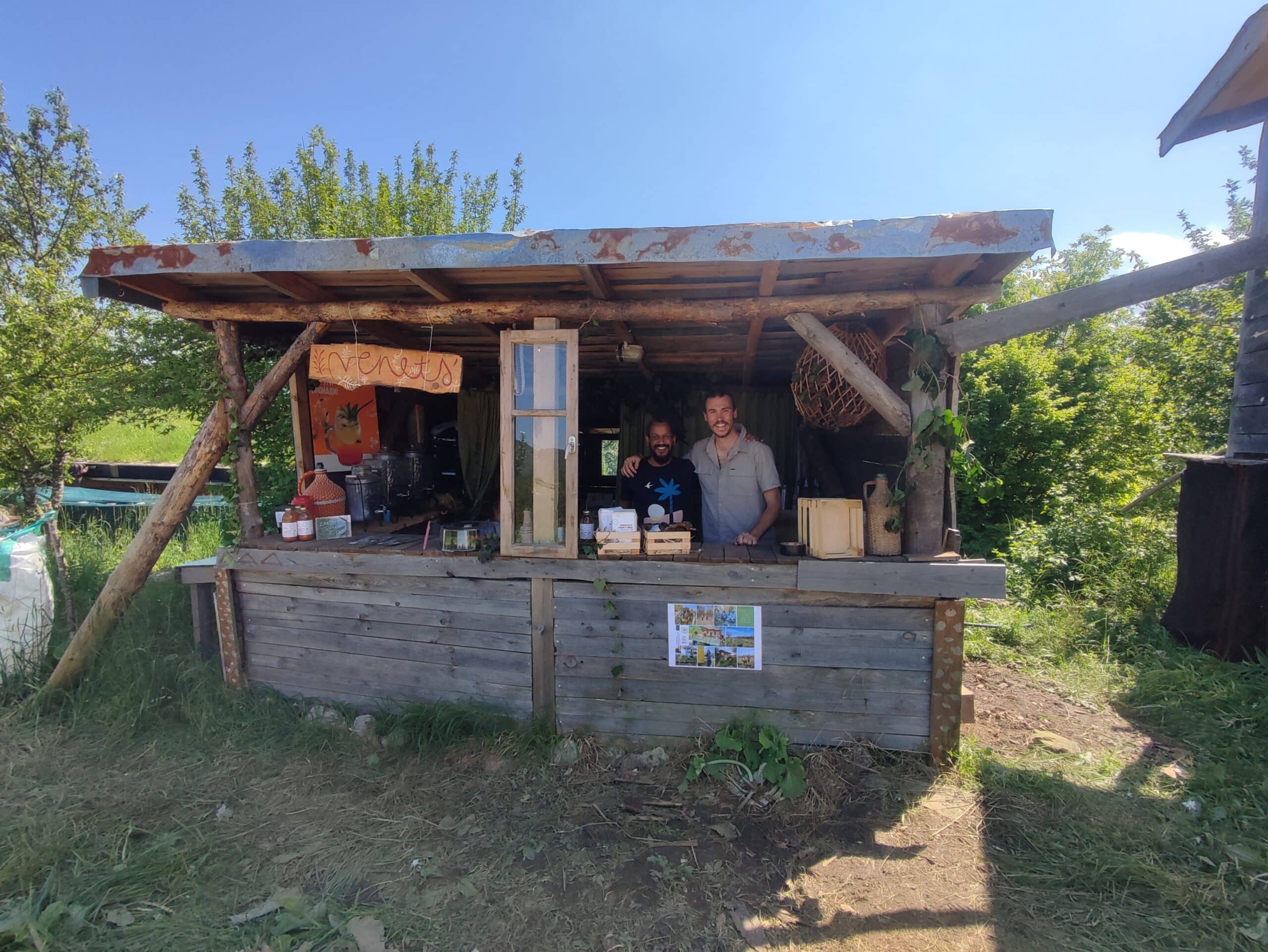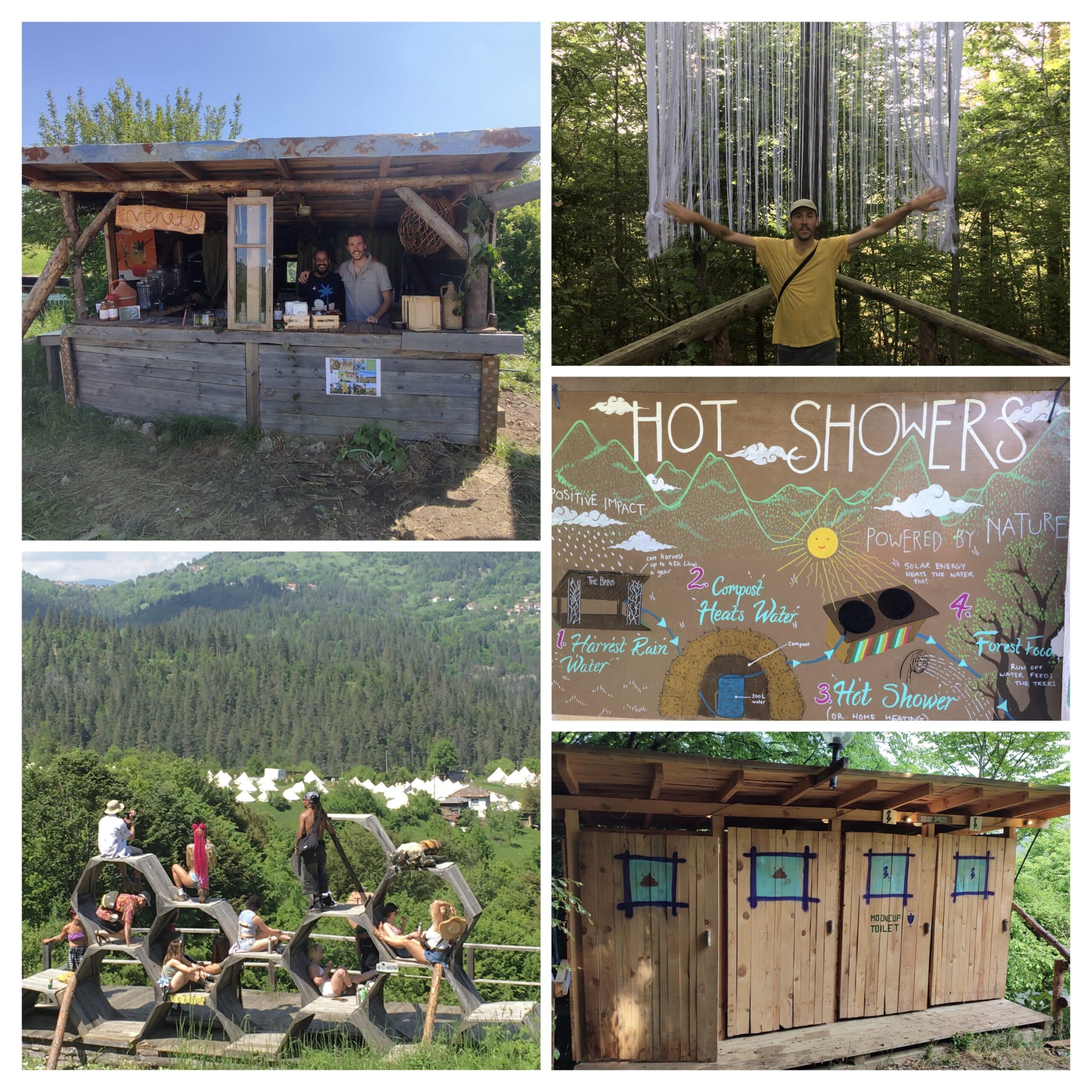Anastasja and Peter:
Dear readers,
As you will know by now (if you’ve read our previous posts, which we hope you did 😉 ) that we were busy the last few weeks with preparing and packing for the Meadows in the Mountains festival. We packed and tied everything neatly into Venets’ ultra-sturdy UAS van, which we would soon learn can face any kind of obstacle and terrain. Then we were off to Sofia with our host Catherine and her partner Adjmal. There we spent one night, and on the next day began the long journey into the Rhodope mountains. When we arrived with the UAS, we made quite some heads turn on our ride through the festival grounds, where we could finally unpack everything in our cute little stand. After two days of preparation, the festival started on Thursday.
How to describe Meadows? Imagine the beautiful, lush, forest-hills of the Rhodope mountains. Then add to that a host of different stages, shops, and other attractions, mostly made of wood and decorated with natural materials, colorful cloth, and magnificent paintings. Into all of this, throw a few thousand (mainly) British, and Bulgarian people in their best eccentric clothing, brimming with colors, glitter, and whatever else catches the eye.
The festival itself had its first edition 10 years ago, when a handful of Brits set their eyes on some pretty meadows on top of a hill in the middle of the forest. Nobody expected how much attention it would get through the years. Nowadays, many Brits make the long journey from London, through Sofia and Plovdiv, and up to the small village Polkovnik Serafimovo. This gives the local economy a great boost, and locals work together with the foreigners to make the festival a great experience for whoever takes up the journey. Here is a little video which was made in honor of this year’s 10-year anniversary:
It is notable that the organizers designed the festival in a sustainable way, by following principles of permaculture and regenerative agriculture. Water is harvested in ponds, from roofs, and wherever else possible, amounting (according to the organizers) to 400.000 liters per year. Moreover, grey water from showers and the kitchens/bars is filtered and used in so-called ‘grey water gardens’. For this purpose, all of the stalls are provided with eco-friendly detergents, and eco-friendly soaps can be purchased by festival-goers for low-impact showering. The showers are also very interesting. They are made from straw-bales and mud, with wooden poles in between. The water is heated with solar energy through black pipes on the roof, as well as internal compost heating (see collage below).
UP LEFT: Peter and Adjmal at Venets’ stand. DOWN LEFT: Festival-goers on the “bee-hive”. UP RIGHT: Peter discovering hidden spots on the festival grounds. MIDDLE RIGHT: Explanation of how the showers work. DOWN RIGHT: Compost toilets, with dry, wet, and mooncup toilet. (photo credit: Anastasja Giacomuzzi)
All toilets are compost toilets, with separate dry and wet toilets, and (much to our excitement) even moon-cup toilets where one can wash menstrual cups (a reusable alternative to single-use pads and tampons). Everywhere, there are also water points where people can refill their bottles, and most visitors carry their own mugs for drinks to avoid the waste from single-use cups. There is much more to tell, so if you’re curious, you can check out the festival website for their environmental actions: Act Now | Meadows In The Mountains
During the weekend we were helping Venets out wherever needed, and talking to people about our volunteering project which we also represented with a little collage. We got a little people-tired after some days, so we decided to take Saturday off and hike to Smilyan, a small village famous for its beans! On the way there we encountered few people, only one shepherd who was pasturing his sheep on the hill.
UP LEFT: Anastasja with sheep. UP RIGHT: Sheep trough in the valley. DOWN LEFT: Typical Smilyan garden. DOWN RIGHT: Yummy Bob Chorba. (photo credit: Peter Spornberger)
When we entered Smilyan, we quickly realized which main crops are grown there. Almost every house has a big garden, where people grow alternating rows of beans and potatoes. Beans and potatoes, as far as the eye can see… We later learned that because of the village’s isolated location (which applies to most places in the Rhodopi mountains), for a long time people had to rely on their own farm production for their sustenance. So beans, potatoes, and in many places also corn became main crops because they grow well in the mountains’ colder climate and are very nutritious. Nowadays, Smilyan beans are protected by a trademark concerning their cultivation. They have many different varieties and colors, and we couldn’t resist buying a bag to try and grow them at home. Then, we strengthened ourselves with a delicious Боб чорба (bean soup) and hiked back to the festival.
In no time the weekend flew by and we were packing on Monday, heading back to our beloved Todorovo.
Talk to you soon,
Anastasja and Peter




